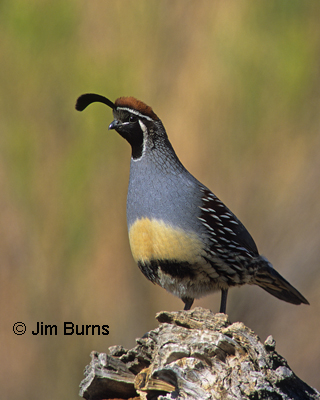
Male Gambel's with their rufous crown, black, teardrop shaped head plume, and black belly patch are a familiar visual and aural delight, especially on early mornings when they tee-up and give their four syllable "chi-CA-go-go" call from bushes, fenceposts, and mailboxes. Gambel's covey up from late summer to late winter, sometimes in flocks of thirty or more birds representing several family groups, but in spring individuals pair up and leave the coveys to nest. Nests are typically a scrape on the ground in the shade of a bush. I have never seen a Gambel's nest and biologists tell me they are nearly impossible to find, but several readers have discovered nests in their backyard and photographed the entire sequence of this species' life history.
Quail broods are large because mortality is high. Gambel's young are precocial--they pop from the egg covered with down, fully formed, and ready to run--but they are only an inch tall and cannot fly for about three weeks. As soon as the down dries, within hours of hatching, they are capable of finding their own food, but they are food for everything else out there--frogs, snakes, roadrunners, grackles, even ants. It is common in the suburbs this time of year to see a family group of a dozen tiny fuzzballs crossing the street, mom in the lead, pop bringing up the rear. Quail are adaptive and can live in close proximity to us, but nature didn't count on cars, curbs, and cats.
Jeani Garrett is the director of Arizona Covey, an organization devoted to quail rescue and rehab. If you find a Gambel's chick or an injured adult, or if you just have questions about protecting the nest that inexperienced Gambel's parents inadvertently made in your flower pot, call and leave your phone number, but be patient about the callback. This is a volunteer organization and Jeani takes in between 500 and 1000 Gambel's chicks every spring.
Jeani has five recommendations for those who find chicks without parents:
- Catch the chick even before you call Arizona Covey.
- Keep the chick warm and dry (95 degrees, not an air-conditioned room).
- Do not water or feed the chick until you talk with a rehabilitator.
- Resist the temptation to raise the chick yourself.
- Do not let people handle or play with the chick.
Gambel's quail was named for William Gambel, a physician and bird collector of the nineteenth century who traveled with an ox train led by Daniel Boone and was the first to write scientific descriptions of many southwestern birds for the Smithsonian. If you've just rescued a Gambel's chick and can't believe anyone hunts this bird, do some math with me--20 million Gambel's in Arizona after a productive (wet) year, an average of 57,000 quail hunters a year with a license that costs, on average, around $35. Quail hunting funds a lot of the research and habitat important to all of us who love birds and the outdoors. Celebrate the vitality of this beautiful species, its partnership with us in the Sonoran Desert, and the unique niche it has carved out in your suburban neighborhood.
If you have an abandoned quail chick or an injured adult contact Arizona Covey at 602-996-1934.
For general questions about feeding or protecting quail in your yard, contact Arizona Covey at azcovey@qwest.net for a brochure full of helpful hints and quail facts. Arizona Covey has educational quail and does school programs.